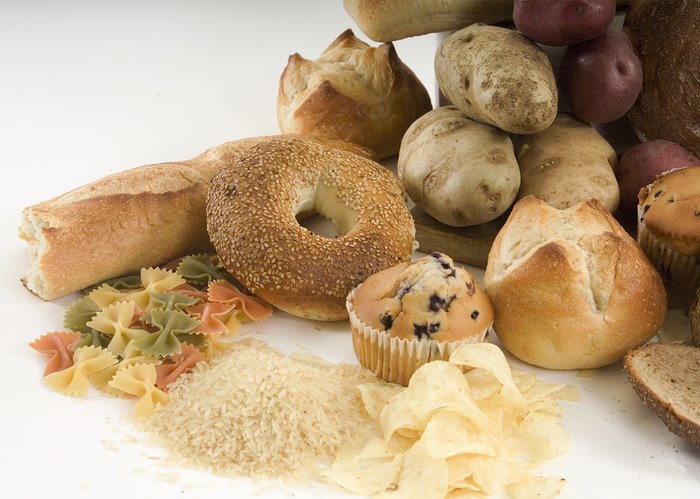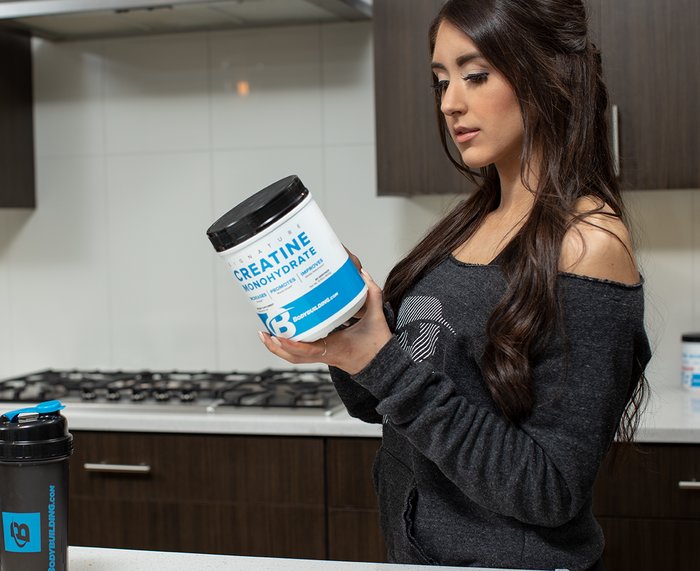Products You May Like
You’re coming off a muscle-building phase, or “bulking phase,” as many may refer to it. You’ve worked hard to put on mass. You’ve been focused and consistent with your workouts, and you’ve gotten noticeably stronger and denser. The time has come to unveil the muscles you’ve built. You want to shed some body fat, but you’re not too stoked about losing your hard-earned gains. How do you go about preserving muscle and also keeping your performance as high as you can?
You must be in a caloric deficit to lose fat. There is no way around it. Here’s what you need to do in order to lean out while maximizing muscle retention:
1. Start with the Most Calories Possible in Your Deficit
The most basic way to create a caloric deficit is to multiply your body weight in pounds by 10-13. Yes, it’s a wide range, but it’s just an estimated starting point—your caloric requirements may be higher or lower based on your age, gender, lifestyle, and goals. I suggest you start on the higher end of the spectrum to give yourself more calories to work with from the beginning.
Say you weigh 150 pounds. Your magic number is 1,950: 150 x 13 = 1,950 calories. So you need to consume 1,950 calories per day in order to lose body fat.
Since body weight is dynamic and fluctuates throughout the week, do not cut calories dramatically if your weight stays the same for a few days. Monitor your weight daily for two weeks in order to make objective decisions. If you’ve lost weight, great! Don’t change a thing. If you’ve stayed the same, drop your intake by 150 calories (which puts you at body weight in pounds x 12).
For most people, losing 0.5-1 percent per week is appropriate. At that pace, you’ll be more likely to keep up your performance at the gym and hold on to more muscle.
2. Eat Your Carbohydrates When You Need Them Most
Nutrient timing has greater importance when you’re in a calorie deficit and trying to maintain muscle mass. You want to make sure that the majority of your carbs (along with some protein) are contained in your pre-workout and post-workout meals.
Some people enjoy having a solid meal of complex carbs and protein 1-2 hours pre-workout, while others enjoy having simple carbs and fast-digesting protein about 30 minutes before. Try both and see what works best for you.

The recommended amount of carbs to get before and after training depends on your overall carb intake, tolerance, and preferences. I have found that consuming a pre-workout meal containing no less than 40-75 grams of carb has helped me to manage fatigue and perform optimally in the gym.
3. Keep Your Protein Consumption High
Higher protein diets increase satiety, create a greater thermic effect, improve mood and cognitive functions, and promote muscle building and recovery.[1-4] These are all things you want, especially when you’re restricting calories.
My recommendation is to eat 0.8-1.2 grams of protein per pound of body weight per day. So, for a 150-pound individual, this means 150 grams of protein per day. The recommended amount of protein before and after training is around 0.18-0.23 grams per pound of body weight, so about 30 grams each for a 150-pound individual.[2]
The easiest way to go about it is to consume protein in every meal. Simply divide your total protein intake by the number of meals that you plan to eat per day. If you need to consume 150 grams of protein and you eat four meals per day, each meal should contain 37 grams of protein.
4. Utilize Refeeds Only as Needed
“Refeeds” are higher calorie days in which you focus on getting a surplus of carbs for the purpose of helping you adhere to the diet. It also assists with muscle retention. The structure of your refeeds will depend on where you are in your diet, your activity level, and your preferences, among other factors.
First, however, let’s talk about what refeeds aren’t. They are not all-you-can-eat buffets or a test of how much junk food you can consume in a single day. Refeeds are mainly to give you the psychological benefit of a break in dieting, and the opportunity to eat more may translate into better gym performance.
My suggestion is to add refeeds to your diet under two conditions:
- You’ve been consistently losing weight for at least four weeks.
- You’re feeling fatigued and lethargic.
In that case, experiment with adding 1,000-2,000 calories on a specific day each week. If you end up needing 2,000 calories, you can opt to have two days where you add 1,000 calories each instead.
As far as the specifics of a refeed go, some people enjoy having carb-focused refeeds, while others benefit more from adding a combination of fats and carbs. At the end of the day, what matters is that you took a break from a caloric deficit, increased calories for 24-48 hours in a structured manner, and now feel more energized and ready to continue with your fat-loss efforts.
5. Do Not Favor Cardio Over Strength
Many people make the mistake of adding intense cardiovascular exercise in order to burn more calories. There’s nothing wrong with this, as adding cardiovascular exercise helps keep fat-burning pathways open and is a great way to use up additional calories. Still, if cardio compromises your strength training, I suggest you rethink your strategy. Most of us already live and work in high-stress environments, so it doesn’t make much sense to add even more stress to your system by performing draining, high-intensity cardio while trying to maintain your gains.

Instead, try increasing your daily NEAT, or non-exercise activity thermogenesis. I’ve found that walking 8,000-10,000 steps per day essentially takes care of my additional calorie burning without compromising my performance at the gym.
6. Prioritize Compound Movements
There is absolutely no reason to cut all compound movements from your program while you’re in a fat-loss phase. Focusing only on isolation movements, high repetitions, and “feeling the burn” doesn’t translate into burning more fat in that specific area. What helped you gain the muscle is what’s going to help you keep it. Continue doing squats, deadlifts, rows, chin-ups, and presses. Try to keep up as much of the training volume as you can, for as long as you can.
Your performance depends upon your training age and your specific training program, but as a general rule, you should be able to maintain most of your intensity at the gym (or even add to it) up to a certain point in your diet, until it’s time to end your diet and start focusing on building again. I’ve found that more often than not, what limits someone’s intensity in the gym is more about the psyche and less about the physiological state.
When you go to the gym, believe in your abilities and work hard. As I mentioned before, what helped you gain the muscle is what’s going to help you keep it.
7. Take a Creatine Supplement
Creatine is one of the most well-researched and safest supplements available. Briefly, creatine is a natural substance that turns into creatine phosphate in the body. Creatine phosphate helps make ATP, which is the energy muscles need in order to contract.

In short, supplementing with creatine helps increase muscle, power, and strength—things you want to hang on to as your body weight drops.[5] You can take in creatine through foods like meat, but you would have to eat a substantially large amount of it to get the creatine levels your body needs to see benefits. Daily consumption of 3-5 grams of creatine monohydrate is sufficient for most people.
8. Prioritize Sleep and Manage Stress
Sleep and stress management are extremely important for your energy and quality of life, but they become of greater importance when calories are restricted. For thousands of years of human history, losing weight was a threat to survival. The human body perceives restriction of calories as a threat to its survival even though it’s not anymore. Still, you need to promote a safe environment in the body to allow fat loss to occur.
Specifically, lack of sleep may lead to changes in hormones that can increase hunger.[6-8] Similarly, high secretions of cortisol and other stress hormones can mask weight loss by retaining water in the body and may lead to increased hunger.[9,10]
With this in mind, be sure to find time to relax, tap into a parasympathetic mode, and do things you enjoy that will reduce stress and promote feelings of well-being and happiness—reading a book, talking to a close friend, playing video games, drawing, etc. Additionally, make it a habit to go to sleep and wake up at the same time each day, getting 7-9 hours of quality sleep. Not only will practicing these habits make it easier to lose fat, but it will also have a positive effect on many other aspects of your life.
9. Assess Your Progress Bi-weekly
One of the main tips for preserving muscle is to focus on slow and consistent fat loss. The following assessment tools used together can provide the most accurate snapshot of your progress as you work through a dieting phase:

- Tracking body weight daily
- Taking measurements—specifically waist and hips—every two weeks
- Taking front, side, and back progress pictures every two weeks
Sometimes the scale won’t budge, but visual changes are apparent, so it’s important to have several assessment tools that measure your progress and not rely on only one. Evaluate your progress every two weeks and adjust your diet and/or activity plan as needed.
As a general rule, let your diet take care of fat loss, and your strength training program take care of muscle retention.
Need more nutritional advice? Head over to the Foundations of Fitness Nutrition course and arm yourself with everything macros, gaining or losing weight, and more—available only on Bodybuilding.com All Access.
References
- Soenen, S., & Westerterp-Plantenga, M. S. (2008). Proteins and satiety: Implications for weight management. Current Opinion in Clinical Nutrition and Metabolic Care, 11(6), 747-751.
- Aragon, A. A., & Schoenfeld, B. J. (2013). Nutrient timing revisited: is there a post-exercise anabolic window?. Journal of the International Society of Sports Nutrition, 10(1), 5.
- Crovetti, R., Porrini, M., Santangelo, A., & Testolin, G. (1998). The influence of thermic effect of food on satiety. European Journal of Clinical Nutrition, 52(7), 482-488.
- Helms, E. R., Zinn, C., Rowlands, D. S., Naidoo, R., & Cronin, J. (2015). High-protein, low-fat, short-term diet results in less stress and fatigue than moderate-protein, moderate-fat diet during weight loss in male weightlifters: A pilot study. International Journal of Sport Nutrition and Exercise Metabolism, 25(2), 163-170.
- Buford, T. W., Kreider, R. B., Stout, J. R., Greenwood, M., Campbell, B., Spano, M., … & Antonio, J. (2007). International Society of Sports Nutrition position stand: creatine supplementation and exercise. Journal of the International Society of Sports Nutrition, 4(1), 6.
- Greer, S. M., Goldstein, A. N., & Walker, M. P. (2013). The impact of sleep deprivation on food desire in the human brain. Nature Communications, 4(1).
- Spiegel, K., Tasali, E., Penev, P., & Van Cauter, E. (2004). Brief communication: sleep curtailment in healthy young men is associated with decreased leptin levels, elevated ghrelin levels, and increased hunger and appetite. Annals of Internal Medicine, 141(11), 846-850.
- Nedeltcheva, A. V., Kilkus, J. M., Imperial, J., Schoeller, D. A., & Penev, P. D. (2010). Insufficient sleep undermines dietary efforts to reduce adiposity. Annals of Internal Medicine, 153(7), 435-441.
- Dugue, B., Leppänen, E. A., Teppo, F. A. M., Fyhrquist, F., & Gräsbeck, R. (1993). Effects of psychological stress on plasma interleukins-1 beta and 6, C-reactive protein, tumour necrosis factor alpha, anti-diuretic hormone and serum cortisol. Scandinavian Journal of Clinical and Laboratory Investigation, 53(6), 555-561.
- Segar, W. E., & Moore, W. W. (1968). The regulation of antidiuretic hormone release in man: I. Effects of change in position and ambient temperature on blood ADH levels. The Journal of Clinical Investigation, 47(9), 2143-2151.
